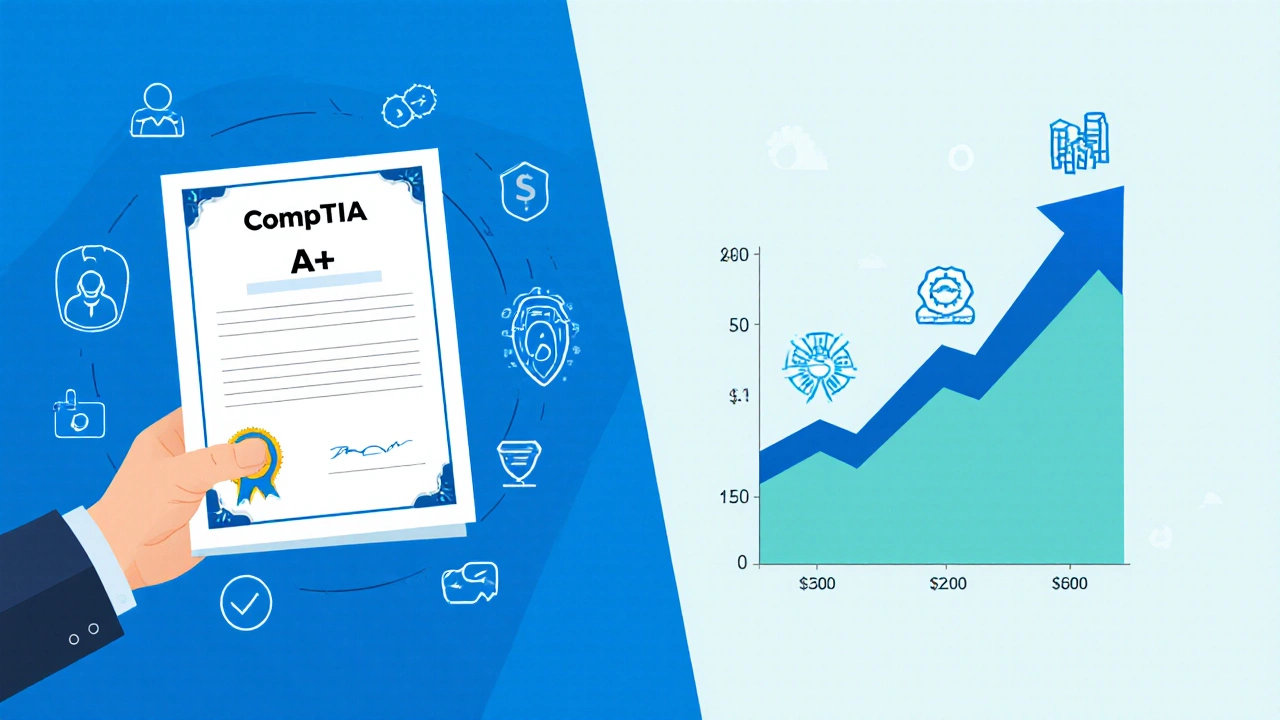
Career Path Salary Estimator
Find Your Highest-Paying Path
Estimate your potential earnings based on course selection, location, and study time
What if you could learn something in weeks, not years, and start earning $70,000 or more without a degree? It sounds too good to be true-but it’s not. Across the world, including in places like Cape Town, Nairobi, and Bangalore, people are skipping traditional education and jumping straight into short, focused online courses that lead to real, high-paying jobs. You don’t need a four-year degree. You don’t need to be a coding genius. You just need the right skill, the right course, and the discipline to finish it.
Stop chasing degrees. Start chasing skills.
For decades, we’ve been told that a university degree is the only path to a good salary. But that’s changing fast. Employers now care more about what you can do than where you went to school. Companies like Google, Amazon, and even local tech startups in South Africa are hiring people based on portfolios, certifications, and real projects-not diplomas.
The easiest courses with high salaries aren’t the hardest to learn. They’re the ones that solve clear, urgent problems. Think of it like this: if you can fix a broken website in two days, you’re worth more than someone who spent four years memorizing theory but can’t write a single line of working code.
1. Cybersecurity Fundamentals (6-8 weeks)
Cyberattacks are rising everywhere. In 2025, South Africa saw a 47% jump in ransomware incidents targeting small businesses. Yet most companies still don’t have anyone on staff who knows how to stop them.
The easiest entry point? A course like Cybersecurity Fundamentals from CompTIA or IBM on Coursera. It covers basic threat detection, password security, phishing awareness, and firewall setup. No math. No programming. Just practical steps you can learn in under two months.
After finishing, you can apply for roles like Security Operations Center (SOC) Analyst or IT Support with Security Focus. Entry-level salaries in South Africa start at R450,000 per year (about $24,000 USD). In the U.S., that role pays $65,000-$85,000. And you don’t need a degree to get hired-just the certification and a few hands-on labs you build yourself.
2. Data Analysis with Excel and Google Sheets (4-6 weeks)
Every business, from a local salon to a global bank, needs someone who can turn messy spreadsheets into clear reports. You don’t need Python or SQL to start. You just need to master pivot tables, VLOOKUP, charts, and basic automation in Excel or Google Sheets.
Free courses like Google’s Data Analytics Certificate on Coursera (or the one from Alison) walk you through real-world examples: tracking sales trends, measuring customer retention, spotting fraud. You’ll learn by doing-no theory overload.
After 6 weeks, you can land a job as a Junior Business Analyst, Sales Coordinator, or Operations Assistant. In Cape Town, these roles pay between R300,000 and R500,000 annually. In the U.S., they start at $60,000. And here’s the best part: you can do this while working a part-time job. Many people finish the course in evenings and weekends.
3. Digital Marketing (Content + Ads) (8-10 weeks)
Businesses need customers. And the easiest way to get them? Online ads and content. You don’t need to be a designer or a writer. You just need to know how to run Facebook and Google Ads, write simple ad copy, and track what works.
Meta’s free Digital Marketing Course and Google’s Skillshop are the most straightforward paths. You’ll learn how to set up a $10 ad campaign, target the right audience, and measure ROI. You’ll also learn how to write headlines that get clicked-not just fluff.
After completing the course, you can work as a freelance digital marketer for local businesses. Or you can join a small agency. In South Africa, freelance digital marketers charge R800-R1,500 per campaign. Full-time roles pay R350,000-R600,000 per year. In the U.S., entry-level digital marketing specialists earn $55,000-$75,000.

4. UI/UX Design (Figma + User Research) (10-12 weeks)
People don’t buy products-they buy experiences. That’s why every app, website, and even government service needs someone who can make it easy to use.
UI/UX design is often seen as complicated, but the basics are simple. Learn Figma (free), understand user flows, and practice redesigning one app you use every day-like your bank’s app or a food delivery service. You’ll learn how to make buttons bigger, reduce clicks, and fix confusing menus.
Google’s UX Design Certificate on Coursera is the most beginner-friendly. It has no prerequisites. You don’t need to draw. You don’t need to code. You just need to think about how people feel when they use something.
Entry-level UX designers in South Africa earn R380,000-R650,000. In the U.S., it’s $70,000-$90,000. And because so few people know how to do this well, demand is high. Many freelancers land their first client within weeks of finishing the course.
5. Technical Support & IT Helpdesk (3-5 weeks)
Every company with computers needs someone to fix them. And right now, there’s a massive shortage of people who can do it calmly, clearly, and quickly.
The easiest path? The CompTIA A+ certification. It teaches you how to troubleshoot printers, reset passwords, install software, and handle basic network issues. You’ll also learn how to talk to non-tech people without sounding like a robot.
This course can be done in under a month. Most people study 1-2 hours a night. The exam is multiple choice. You can take it online from home.
After passing, you can work as a Helpdesk Technician in banks, hospitals, or even remote support for global companies. In South Africa, salaries start at R280,000. In the U.S., it’s $50,000-$65,000. And because this job is always needed, it’s one of the most stable entry points.
Why these courses work when others don’t
Not all online courses are created equal. Many promise high pay but require years of study, expensive tools, or advanced math. The courses above work because they:
- Have clear, measurable outcomes (you can show your work)
- Use free or low-cost tools (Figma, Excel, Google Ads)
- Don’t require prior experience
- Are recognized by employers worldwide
- Let you start earning while learning (freelance gigs, part-time roles)
They’re not magic. But they’re real. And they’re available right now.
What to avoid
Stay away from courses that promise:
- “Get rich quick with AI” (unless you’re a data scientist)
- “Become a blockchain developer in 2 weeks” (you need years of coding first)
- “Earn $10,000/month as a content creator” (only 0.1% do)
These are hype traps. The real high-paying, low-effort paths are boring. They’re about solving small problems well-over and over again.

How to start today
You don’t need to wait. Here’s your 7-day plan:
- Choose one course from the five above.
- Sign up for the free version (most have free trials or free audits).
- Complete Module 1 by Day 3.
- Build one small project-fix a spreadsheet, redesign a button, write an ad.
- Post it on LinkedIn or a free portfolio site like Notion.
- Apply to 3 entry-level jobs or freelance gigs by Day 7.
That’s it. No degree. No debt. Just action.
Real stories, real results
In Cape Town, a 22-year-old single mom finished the Google Data Analytics Certificate in 10 weeks. She started freelancing for local shops, tracking their sales. Six months later, she was hired full-time at a logistics company-earning R420,000 a year.
In Lagos, a 30-year-old taxi driver learned CompTIA A+ online. He now runs a small IT repair shop and hires two others. He makes more than he ever did driving.
These aren’t outliers. They’re examples of what happens when people stop waiting for permission and start learning what actually matters.
Final thought: Your time is worth more than you think
You don’t need to be the smartest person in the room. You just need to be the one who shows up, finishes the course, and builds something real. The easiest course with the highest salary isn’t the one with the flashiest title. It’s the one that solves a problem businesses are desperate to fix.
Start small. Finish something. Then do it again.
Can I really get a high salary without a degree?
Yes. Many high-paying tech and business roles no longer require degrees. Employers care more about certifications, portfolios, and proven skills. Jobs like cybersecurity analyst, data analyst, and IT support technician often hire based on certificates from Google, IBM, or CompTIA-even without a university diploma.
How long does it take to complete these courses?
Most of these courses take between 3 and 12 weeks if you study 5-10 hours per week. Some, like IT support or Excel skills, can be mastered in under 5 weeks. The key is consistency-not speed. Finishing one course well matters more than rushing through five.
Are these courses free?
Many have free versions. Google’s Data Analytics and Meta’s Digital Marketing courses are free to audit. CompTIA A+ and IBM’s Cybersecurity courses offer free trials or discounted pricing. You can learn the core skills for free. Paying gives you a certificate and graded projects, which help with job applications.
Do I need a computer or internet to start?
Yes, but you don’t need a high-end machine. A basic laptop or even a good smartphone with internet access is enough to start most of these courses. Tools like Excel, Figma, and Google Ads work on low-end devices. If you can browse the web, you can begin.
What if I’m not good at tech?
You don’t need to be tech-savvy. These courses are designed for absolute beginners. Cybersecurity teaches you how to spot fake emails. Data analysis teaches you how to use buttons in Excel. UI/UX teaches you to think like a user. If you can follow instructions and ask questions, you can succeed.
Next steps
If you’re ready to move forward, pick one course from this list and start today. Don’t wait for the perfect moment. There isn’t one. The best time to start was yesterday. The second best time is now.
Bookmark this page. Come back in 30 days. Ask yourself: Did I finish one module? Did I build something? Did I apply for a job? If the answer is yes-you’re already ahead of 90% of people who just think about it.





